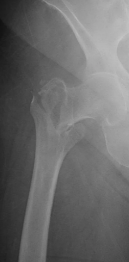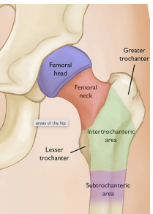Hip Nailing & Intertrochanteric Femur Fracture Postoperative Protocol
The Reno Orthopedic Center Fracture and Trauma Surgeons have created postoperative fracture protocols for our patients. These are based on the latest orthopedic science and literature in order to give patients the most up to date care. Their content is designed to explain what type of injury was sustained, the type of surgery that was done and simple instructions for weight bearing, wound care, physical therapy, medicine and diet issues. Patients will hear similar information in each postoperative visit but it is easy to forget what is said. The following protocol is designed to help patients in their healing with a single resource for frequently asked questions.
What Was Broken
You broke the top part of the thigh bone which is part of the hip. The type of break you had is called an intertrochanteric femur fracture.

Preoperative x-ray of intertrochanteric femur fracture.

Illustration of the femur bone. Reproduced with permission from OrthoInfo. © American Academy of Orthopaedic Surgeons. https://orthoinfo.org/
What Was Done in Surgery
Your hip fracture was fixed with a titanium rod called a cephalomedullary nail. This construct usually consists of one large diameter rod placed inside the bone where your bone marrow is, a large screw that connects to the rod up towards the hip joint and a smaller screw down by the knee. This metal does not cross the hip or knee joint in order not to restrict hip or knee range of motion when the bone heals.

Postoperative x-ray of an intramedullary nail.
Home Health vs Skilled Nursing Facility vs Rehabilitation Hospital
Most patients stay in the hospital after hip surgery for 1-2 days. Some are able to go home unassisted. Others can go home with a Home Health Agency checking in on them to help with bathing and therapy. If a patient is unsafe on their own, they will need to go to a skilled nursing facility or rehabilitation hospital. In the hospital you will meet with physical therapists, occupational therapists, social workers and physical medicine and rehabilitation doctors who will help find which solution is best.
Follow Up Appointment
You should see your surgeon or his physician assistant 10-14 days after surgery. Usually, this appointment is made when you schedule surgery. If you do not have one, please call the office to schedule at 775-786-3040 as soon as you can. You will be seen at 2 weeks, 6 weeks and 3 months from surgery where the provider will examine you and x-rays will be taken to follow bone healing.
Wound Care
Your wound was closed with either sutures or staples. After 2 days you can take off the dressing. If the wound is dry, you do not need to cover it with a new bandage. If it is leaking, replace dressing with a clean gauze pad and tape.
Showering
You may shower immediately after surgery. Your dressing from surgery is waterproof. If it gets wet, remove the bandage, and place a new one. Do not immerse your wound in a bath or hot tub until your stiches or staples are removed
Pain Control
You have been given a prescription for narcotic pain medication. You can take 1-2 pills every 4-6 hours. It is ok to take anti-inflammatory medicine like Motrin (ibuprofen) or Tylenol (acetaminophen) as well. Do not take more than 4 grams of Tylenol a day or it can hurt your internal organs. The orthopedic surgeon by law can only give you narcotic pain medicine for 2 weeks after surgery. This must be prescribed in only a 5 day supply each time. If you already get narcotics from your primary care doctor or pain management doctor the orthopedic surgeon cannot write you a separate prescription. If you need prolonged narcotics, we can refer you to a pain management specialist. If these rules are bent, the orthopedic surgeon can lose his medical license, insurance contracts and be unable to care for other patients like you. Please respect these regulations.
Marijuana
THC and CBD products can be helpful for postoperative pain and decrease the amount of narcotics you need. In Nevada, marijuana is legal, and you do not need a doctor’s prescription to get it. THC use avoids the constipation and addiction potential associated with narcotic use. Edible use avoids the other risks associated with smoke inhalation and has more controllable dosing.
Diet
Eat a well-balanced diet. If you are diabetic keep your blood sugars well controlled. High blood sugar can put you at risk for infection, wound complications and the bone not healing (nonunion).
Sutures/Staples
Your wound has been closed with sutures or staples depending on your surgeon’s preference. They will be removed at your first postoperative follow up appointment 10-14 days after surgery.
Weight Bearing
You can be weightbearing as tolerated immediately after surgery. You will have pain in your leg while it heals but it is safe to walk on it. Move your hip, knee, and ankle as much as possible to avoid getting stiff.
Blood Clot Prophylaxis
Patients with pelvis and leg fractures are at risk to get blood clots in the legs that can dislodge and travel in the bloodstream to the lungs causing disability or death. There are several ways to decrease the risk of this complication. In the hospital you are given shots in the belly called Lovenox and have pneumatic compression devices on your legs. Once discharged home take one baby aspirin(81mg) a day for 2 weeks. Walking and moving as much as you can is also preventative.
Physical Therapy
Most patients with hip fractures do not require physical therapy other than gait training to make sure you are using your assistive devices like a walker or cane correctly. Most patients need about 3-4 months of therapy to regain their preinjury range of motion and strength.
Return to Work
Patients can usually return to a desk job or light duty after a few days. Return without restriction to jobs that require heavy lifting or manual labor usually takes about 6 weeks.
Driving
You should not drive a car if you are still taking narcotic pain medication. Just remember that your reaction time will be slow for first 6 weeks so do not tailgate or drive too fast
Hardware Removal
The intramedullary nail usually stays in for life and are not routinely removed. Individual screws sometimes require removal to stimulate bone to heal in a process called dynamization
Healing Time
Hip fractures treated with surgery take about 3 months to heal completely. Younger patients heal slightly faster and older patients or those with diabetes take slightly longer to heal.
